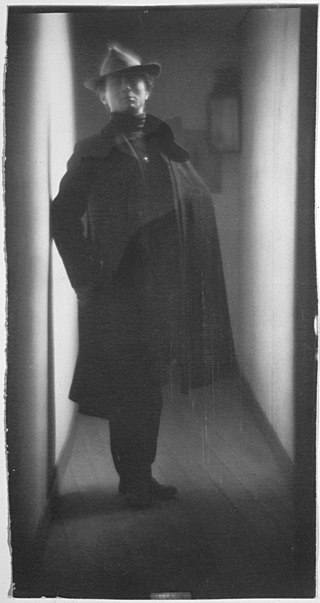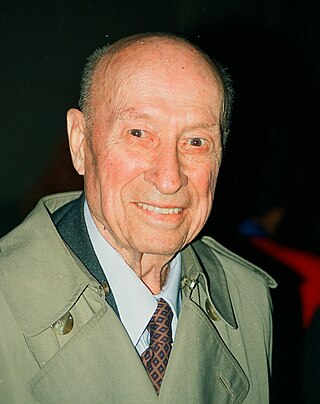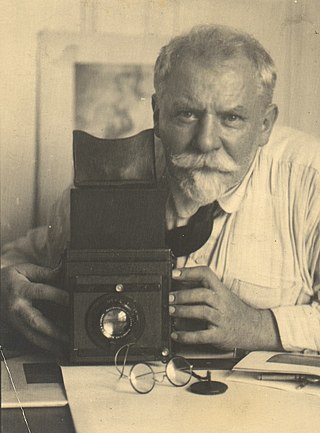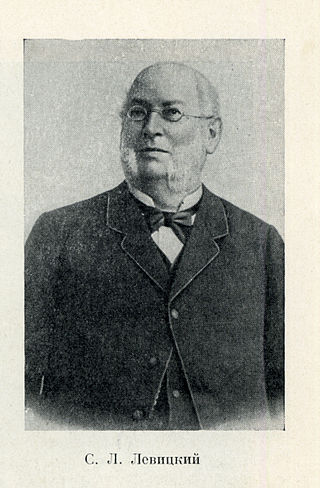Related Research Articles
Photography is the art, application, and practice of creating durable images by recording light, either electronically by means of an image sensor, or chemically by means of a light-sensitive material such as photographic film. It is employed in many fields of science, manufacturing, and business, as well as its more direct uses for art, film and video production, recreational purposes, hobby, and mass communication.

Charles Augustus Lindbergh was an American aviator, military officer, author, inventor, and activist. On May 20–21, 1927, Lindbergh made the first nonstop flight from New York City to Paris, a distance of 3,600 miles (5,800 km), flying alone for 33.5 hours. His aircraft, the Spirit of St. Louis, was designed and built by the Ryan Airline Company specifically to compete for the Orteig Prize for the first flight between the two cities. Although not the first transatlantic flight, it was the first solo transatlantic flight, the first nonstop transatlantic flight between two major city hubs, and the longest by over 1,900 miles (3,000 km). It is known as one of the most consequential flights in history and ushered in a new era of air transportation between parts of the globe.

Ansel Easton Adams was an American landscape photographer and environmentalist known for his black-and-white images of the American West. He helped found Group f/64, an association of photographers advocating "pure" photography which favored sharp focus and the use of the full tonal range of a photograph. He and Fred Archer developed an exacting system of image-making called the Zone System, a method of achieving a desired final print through a deeply technical understanding of how tonal range is recorded and developed during exposure, negative development, and printing. The resulting clarity and depth of such images characterized his photography.

Joseph Nicéphore Niépce, commonly known or referred to simply as Nicéphore Niépce, was a French inventor, usually credited with the invention of photography. Niépce developed heliography, a technique he used to create the world's oldest surviving product of a photographic process: a print made from a photoengraved printing plate in 1825. In 1826 or 1827, he used a primitive camera to produce the oldest surviving photograph of a real-world scene. Among Niépce's other inventions was the Pyréolophore, one of the world's first internal combustion engines, which he conceived, created, and developed with his older brother Claude Niépce.

Robert Capa was a Hungarian-American war photographer and photojournalist as well as the companion and professional partner of photographer Gerda Taro. He is considered by some to be the greatest combat and adventure photographer in history.

Alfred Stieglitz was an American photographer and modern art promoter who was instrumental over his 50-year career in making photography an accepted art form. In addition to his photography, Stieglitz was known for the New York art galleries that he ran in the early part of the 20th century, where he introduced many avant-garde European artists to the U.S. He was married to painter Georgia O'Keeffe.

Edward Jean Steichen was a Luxembourgish American photographer, painter, and curator, renowned as one of the most prolific and influential figures in the history of photography.

Ernst Haas was an Austrian-American photojournalist and color photographer. During his 40-year career, Haas bridged the gap between photojournalism and the use of photography as a medium for expression and creativity. In addition to his coverage of events around the globe after World War II, Haas was an early innovator in color photography. His images were disseminated by magazines like Life and Vogue and, in 1962, were the subject of the first single-artist exhibition of color photography at New York's Museum of Modern Art. He served as president of the cooperative Magnum Photos, and his book The Creation (1971) was one of the most successful photography books ever, selling 350,000 copies.

Harry Morey Callahan was an American photographer and educator. He taught at both the Institute of Design in Chicago and the Rhode Island School of Design.

Joel Meyerowitz is an American street, portrait and landscape photographer. He began photographing in color in 1962 and was an early advocate of the use of color during a time when there was significant resistance to the idea of color photography as serious art. In the early 1970s he taught photography at the Cooper Union in New York City.

Garry Winogrand was an American street photographer, known for his portrayal of U.S. life and its social issues, in the mid-20th century. Photography curator, historian, and critic John Szarkowski called Winogrand the central photographer of his generation.

Arnold Genthe was a German-American photographer, best known for his photographs of San Francisco's Chinatown, the 1906 San Francisco earthquake, and his portraits of noted people, from politicians and socialites to literary figures and entertainment celebrities.

Heliography from helios, meaning "sun", and graphein (γράφειν), "writing") is the photographic process invented, and named thus, by Joseph Nicéphore Niépce around 1822, which he used to make the earliest known surviving photograph from nature, View from the Window at Le Gras, and the first realisation of photoresist as means to reproduce artworks through inventions of photolithography and photogravure.

Russell Werner Lee was an American photographer and photojournalist, best known for his work for the Farm Security Administration (FSA) during the Great Depression. His images documented the ethnography of various American classes and cultures.
Volkmar Kurt Wentzel was a German American photographer and cinematographer. He worked for nearly 50 years for the National Geographic Society as a darkroom technician and photographer, and his professional and personal work was highly acclaimed. He was one of the first people to take photographs of then-little known country of Nepal, and was noted for documenting the final years of many of the traditional tribal kingdoms of Africa.

Anne Wardrope Brigman was an American photographer and one of the original members of the Photo-Secession movement in America.
Gen Ōtsuka was a renowned Japanese photographer.

Frank Eugene was an American-born photographer who was a founding member of the Photo-Secession and one of the first university-level professors of photography in the world.

Count Sergei Lvovich Levitsky, is considered one of the patriarchs of Russian Empire photography and one of Europe's most important early photographic pioneers, inventors and innovators.
Sam Falk was an early- and mid-twentieth-century American photojournalist who worked for The New York Times from 1925 to 1969, and wrote and photographed for other publications.
References
- ↑ "Ivan Dmitri". Olympedia. Retrieved 2 August 2020.
- 1 2 3 Morton County Historical Society (1975). Peterson, Marion Plath (ed.). Morton prairie roots. Dallas, Texas: Taylor Publishing Co. p. 212. OCLC 2062977.
- ↑ Official website
- 1 2 3 "Theodore Roosevelt Rough Rider Award". State of North Dakota. Archived from the original on 2010-05-27. Retrieved 2010-07-16.
- ↑ SNAC Cooperative website
- ↑ SNAC Cooperative website
- ↑ Karsh, Yousuf (2009). Regarding Heroes. Jaffery, New Hampshire: David R. Godine. pp. 1893–1899. ISBN 978-1-56792-359-9. OCLC 256769548.
- ↑ Guide to the Arthur d'Arazien Industrial Photographs, Smithsonian
- ↑ SNAC Cooperative website
- ↑ Website